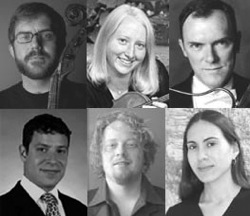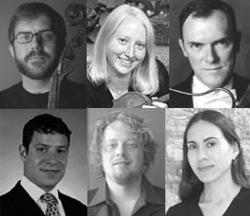
Still, this doesn’t mean the group lacks focus. This ensemble proclaims a particular specialty in “the virtuoso instrumental music of the seventeenth century,” and virtuosity will certainly be on full display in their upcoming performance March 23 at the Berkeley City Club, part of the Berkeley Chamber Performances series and featuring guest recorder/oboe player Kathryn Montoya and viola da gamba/violone player Josh Lee. But while fast fingerwork seems organic to a program titled “Baroque Bravado,” audiences will also find music of high drama and poignant lyricism underneath the razzle-dazzle.
Passamezzo Moderno’s diversity extends to the geographic range of its repertory, even if the composers themselves are all mid- to late-Baroque contemporaries. Representing England is Henry Purcell’s Fantazia: Three Parts on a Ground, in which a stately melody and simple harmonic progression is transformed into highly novel variations over the unvarying ground bass. Georg Frideric Handel’s Sonata in G Minor, Op. 2, No. 8 for violin, oboe, and continuo is a more doubtful case, with lingering questions about both its authorship and its original scoring, yet the piece itself is an undeniable charmer. Frenchman Marin Marais’ Pièces en Trio (Suite in C major) for recorder, violin, and continuo showcases great diversity across eight dance movements, laying out a veritable feast for the ears.
Representing the Germans are two works by the immensely prolific Georg Philipp Telemann, the Sonates Corellisantes, Sonata No. 1 in F Major and 12 Canons melodieux, ou 6 sonates en duo: Canonic Duo No. 2 in G Minor. Another German, Johann Pachelbel, wrote a famous little canon that will also be performed here — though people may not know its original scoring (for three violins and basso continuo), or the fact that it was originally paired with a gigue. Passamezzo Moderno’s own Kanon & Gigue restores the gigue but shifts the instrumentation to recorder, two violins, and continuo, placing their own stamp on a timeworn classic.
The Czech-born Jan Dismas Zelenka spent the heart of his career in Dresden and earned the esteem of no less a figure than J.S. Bach. Recently, Zelenka has enjoyed a powerful resurgence in popularity, and, judging by his Sonata in B-flat Major, No. 3, for violin, oboe, bassoon, and continuo, it’s easy to see why. The slower movements are especially touching, with aching melodies in the opening Adagio and a wistful, third-movement Largo.
Finally, from Italy there’s Antonio Vivaldi and his Concerto in G Minor, “La Notte,” for recorder, bassoon, two violins, and continuo. It’s unclear what this “night” concerto is meant to signify programmatically, other than that two of its four movements bear the subtitles “Phantasms” and “The Dream,” yet the madcap figurations and vivid melodic writing are a guaranteed crowd-pleaser.

